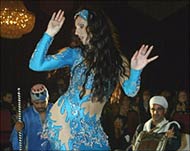Now, China shakes to belly dancing
With cheap Chinese textiles dominating global markets, the world needs to ready itself for the next Made In China export: belly dancers.

Flaunting shimmying hips, waving arms and shaking bodies, belly dancing is the latest craze to hit China’s dance floors as its finds a niche among young middle class urbanites looking for novel ways to enjoy themselves.
Opening her first school last year, former dance school graduate He Ying and her two female business partners were first drawn by the dance’s sensual qualities.
“When I first started I thought it was beautiful and a little sexy,” says full-time belly dance teacher Li Jia.
She describes the Middle Eastern art form as “easy to study but hard to perfect … [and] a great way to do exercise”.
The most proficient belly dancer among the trio, Li, who uses the English name Eva, was the first mainland Chinese to perform at this year’s Egyptian Belly Dancing Festival.
After showing off pictures of herself alongside Middle Eastern belly dancers and teachers, Li and her colleagues then proudly relate the number of television and stage shows they have each been on.
Suddenly, Li grabs a piece of muslin and re-enacts her performance, a series of elaborate twists and twirls interspersed with seductive glances and fluttering eyelashes.
Communal event
Enjoyed for centuries, belly dancing may have the power to titillate but its origins are far more culturally artistic.
Traditionally performed for a female audience, belly dancing today has become a communal event, with dancers brought out for weddings, births and local festivals.
 |
|
Belly dancing joins hip-hop and |
In China, the dance is know as dupiwu, literally belly skin dancing.
With China reaching out to the world, belly dancing joins hip-hop and Latino beats as recent additions to the country’s cultural and leisure scene.
All three dance imports have become popular as increasing numbers of Chinese find themselves with time on their hands, money to spend, and in the case of He Ying and her colleagues, the self-confidence to publicly express themselves.
Modern China is in the grip of a consumer revolution; shopping thoroughfares reverberate to the sounds of thousands of jostling bodies while ubiquitous shop door speaker systems squawk out the latest sale offers.
According to investment bankers Credit Suisse First Boston, consumer spending will quintuple in the next decade to $3.07 trillion, an average increase of 18% a year. And by 2009, says Merrill Lynch, China will account for 20% of the world market in luxury goods.
Enviable figure
Such enviable growth figures continue to attract global consumer and leisure service providers.
This summer, fashion magazine Vogue launched their first China issue, while at the same time, officials from the International Cricket Council talked about their interest in cracking open the China market.
And when business hours are over, the nightlife begins. Now, barely a month goes by without a major production touring the China circuit. Tap-dancing extravaganza Riverdance and the human circus act Cirque du Soleil have become regulars.
 |
|
Students flock to schools |
All this demonstrates a society on the move.
“For me life is about being happy. I want to have hobbies, make money, spend money and make friends,” explains Li Jia.
“Men, I have no time for.”
Sporting huge dangly earrings and inch-long sparkly nail extenders Li typifies a new type of Chinese woman, one that may not quite “hold up half the sky” as Mao Zedong once said, but nevertheless is able to enjoy a hitherto unattainable level of personal and financial independence.
Already overseeing eight franchised schools in the nation’s capital and planning to expand nationwide He Ying appears confident about the future.
Her first school, (Chinese language website www.manybellydance.com) is located in the northern Beijing district of Haidian. A converted apartment serves as an office-cum-dance studio, it sees more than 300 students spin across the floor on a weekly basis.
Choreographed moves
Taking off their shoes and donning traditional costumes that Li picked up on her summer trip to Cairo, the 15 young female professionals, witnessed by this correspondent in Beijing, begin a series of choreographed moves.
Giggling nervously at the sight of a foreign onlooker, they each take their cue from Li, who stands in front of a ceiling-to-floor mirror and begins by loosening her shoulders and twirling her hands.
 |
|
Belly dancing is a cultural art |
Moving their arms up and down like a giant wave rippling across their upper bodies, the group starts to gyrate to the wails of Egyptian pop music.
Among them is Li Yanfen. Originally from southern Guangdong province, she came to the capital to make her fortune.
“This is by far the most beautiful dance I have done,” she says, echoing the sentiments of her teacher. Though fairly proficient, like the other students she struggles with the “shimmy” (shaking the hips) and “camel” (drawing the stomach in and up like a camel’s hump).
Travelling to Beijing on her own and working part time jobs during the day, she hopes that like her teacher Li Jia, her evening dance classes will lead to greater things.
A little more study and who knows – she may soon be coming to a belly dancing show near you.